Introduction
Demand and supply are the foundations of economic analysis in the interaction of the two market forms. The law of demand and supply works in divergent ways in the sense that, when prices of commodities change, demand and supply will change in opposite direction holding other factors constant. This depends on the nature of goods as forces of demand and supply are dictated by the type of goods in question.
For instance, demand or supply for some goods will respond more than a change in price as compared to others. Thus, the corrective role played by good-elasticity curves in the market. In addition, besides price effects on demand and supply of goods, changes in technology, climatic conditions, and government regulations such as taxes are also relevant. Companies operate in different market structures such as perfect competition, monopoly, and oligopoly.
This paper will analyze how the consumption of alcoholic drinks behaves in different scenarios. First, it discusses the changes in supply and demand when the government imposes taxes on the alcoholic drink. Secondly, it analyzes the impact of taxes on consumers’ and producers’ welfare. Also, it will discuss how taxes impact on consumption of alcohol in a monopoly and perfectly competitive market. Finally, it will discuss other alternative ways the government of Australia can use to discourage the consumption of alcoholic drinks.
Demand & supply of alcoholic drinks and the impact of taxes on the welfare of consumers and suppliers
Demand and supply of alcoholic drinks
Market equilibrium for alcoholic drinks is attained at the point of intersection of demand and supply curve. Generally, the equilibrium position maximizes the total benefits received by buyers and sellers. Equilibrium condition is not static as any factor which affects demand and supply. For instance, the imposition of taxes will cause an increase in the price of alcoholic drinks (Tewar, 1996, p. 12). This increase causes a movement along the demand and supply curve as illustrated in the figure below.
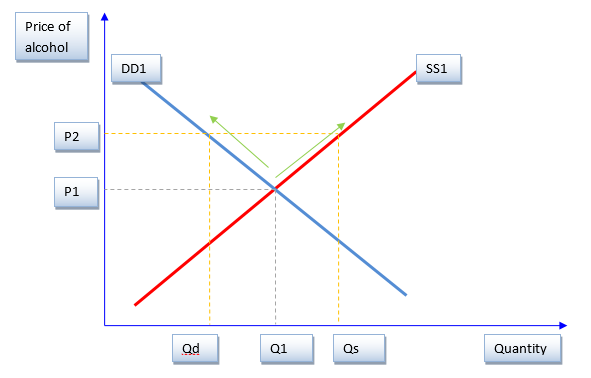
From the above graph, DD1 is the demand curve for an alcoholic drink while SS1 is the supply curve. Q1 and P1 are the equilibrium price and quantity respectively at ceteris paribus. The imposition of taxes on alcoholic drinks causes an increase in price to a new level P2.
This is captured by movement in the supply and demand price as shown by the arrows. With the increase in prices, suppliers would be willing to sell more quantity of alcoholic at Qs while the consumers will cut their consumption of alcohol to a lower level say Qd. This creates disequilibrium in the market as quantity supplied exceeds demand. In this state, both the suppliers and consumers do not benefit. However, the impact of price on the consumers and suppliers will depend on the responsiveness of alcohol drinks to changes in price (Boyes and Michael, 2008, p. 135).
Impact of taxes on the welfare of consumers and suppliers
The changes in demand and supply can affect both suppliers’ and consumers’ welfare. Mankiw (2009) defines welfare economics as the study of how the allocation of resources affects economic well-being. Welfare economics examines the benefits that buyers and sellers receive from taking part in a market. Welfare analysis focuses on the consumer and producer surplus. Consumer surplus is the difference between the quantity of a good a buyer is willing to pay and the actual amount he pays, while producer surplus is the fiscal value a seller receives for a good less the cost the seller incurs on it (Roger, 2008, p.32).
Consumer surplus captures the price a consumer is willing to pay over and above the equilibrium price (also known as the market-clearing price). Producer surplus is the price a producer receives over and above the cost of production. The demand and supply curve for the initially unregulated firm for alcoholic drinks is shown in figure1.1 below.
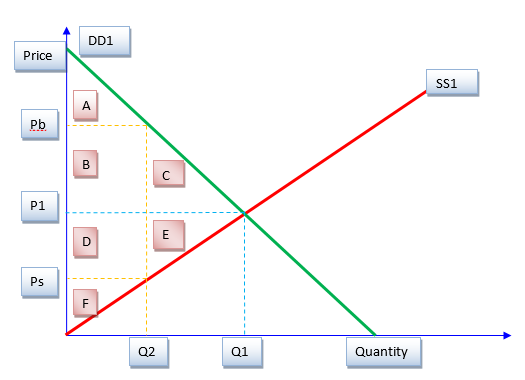
From the figure above, the original demand curve for the firm is shown by line DD1 and the original supply curve is shown by SS1. Equilibrium price and quantity for alcoholic drinks are P1 and Q1 respectively, holding other factors constant. Before the imposition of taxes, consumer surplus is shown by area A+B+C while the producers surplus is shown by area D+E+F. Since there are no taxes, government revenues are zero.
The total surplus is the area between the supply and demand curves unto the equilibrium quantity and it is area A+B+C+ D+E+F (Mankiw, 2009, p.156; Tewar, 1996, p. 67). The imposition of taxes affects the prices of alcoholic drinks. The price paid by the buyer increases from P1 to Pd. This reduces the consumer surplus to area A only. The price received by the supplier declines from P1 to Ps. This reduces the producer surplus to area F only. The quantity sold falls from Q1 to Q2. The total government revenue is captured by area B+D. The total surplus in the market is now shown by area A+B+D+F (Boyes and Michael, 2008, p. 168).
The imposition of taxes causes a change in welfare. Consumer and producer surplus declines while government revenue increases. The total surplus declines by area C+E. This implies that the loss from the consumers and suppliers exceed the total revenue received by the government. This loss is known as a deadweight loss. Mankiw (2009) defines it as the reduction in overall surplus due to market distortions.
Taxes results in deadweight losses since it prevents sellers and buyers from achieving gains from business (Mankiw, 2009, p.157). Therefore, the net effect of an increase in tax by the government of Australia is a reduction of the welfare of the society (producers, consumers, and the government).
Elasticity of demand of alcoholic drinks and disequilibrium in the market of alcohol
Elasticity of demand of alcoholic drinks
Elasticity is a measure of responsiveness of demand or supply to changes in market condition. Price elasticity of demand is a measure of responsiveness of quantity demanded of a good to changes in own price (Rittenberg and Tregarthen, 2009, p.28). Consumption of alcoholic drinks will change in different ways depending on the elasticity of alcohol. Assume that the demand of alcohol is perfectly price inelastic. An increase in price of alcohol will not affect the quantity consumed as shown in the figure below.
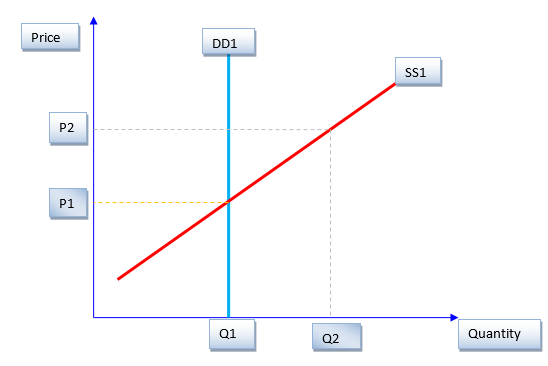
From the above graph, the equilibrium price and quantity are P1 and Q1 respectively, holding other factor constant. Since alcohol is perfectly inelastic, the demand curve takes a vertical line as shown by DD1. Supply curve is upward sloping as shown by SS1. An increase in price resulting from imposition of taxes causes an increase in price to P2. The quantity demanded will not change while the quantity supplied will increase creating disequilibrium (Bernanke and Frank, 2003, p. 122). Therefore, imposing taxes on a perfectly inelastic demand will not change consumption of alcohol.
Quantity If the demand curve of alcoholic drinks is inelastic, an increase in price would lead to a less than decline in quantity demanded. That is the quantity demanded changes by a smaller ratio than price. On the other hand, if demand is perfectly elastic, change in price will lead to a more than change in the consumption of alcohol. Demand is more than responsive to change in price (Bernanke and. Frank, 2003, p. 122; Rittenberg and Tregarthen, 2009, p.29). Changes in demand and supply are shown in the figure below.
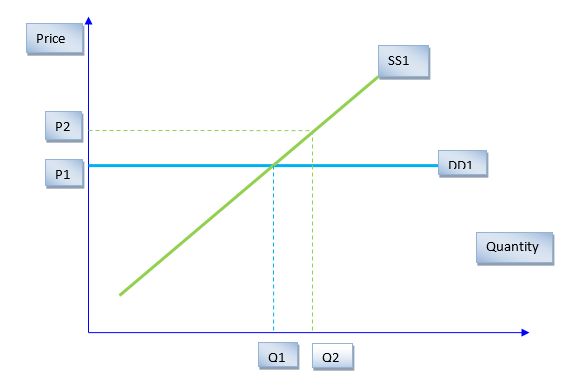
In the graph above, the demand curve is DD1 while the supply curve is SS1. The equilibrium quantity is Q1 while the equilibrium price is P1 ceteris paribus. An increase in price say to P2 leads to an increase in quantity supplied. The change in consumption cannot be quantified as quantity consumed changes infinitely. Imposing tax on such a product may adversely affect the government revenue. However, if the alcoholic drink is elastic then an increase in price will cause a more than change in consumption. That is a unit change in price of alcohol will lead to a more than one unit decline in quantity demanded (Rittenberg and Tregarthen, 2009, p.29).
Disequilibrium in the market for alcohol
Equilibrium position in the market is vital as it is the point where both suppliers and consumers benefit. Increase in price of alcohol causes distortion in the equilibrium as the quantity supplied exceeds the quantity demanded as consumers will be forced to cut their intake of alcoholic drinks. This creates a situation of excess supply or a surplus in the market (Mankiw, 2009, p. 77). In this situation, the suppliers will be the most affected as they cannot sell all they want at the going market price. Imposition of taxes on alcoholic drinks will affect suppliers more than the consumers. However, this would also depend on the ability of the supplier to shift the tax burden on to the consumer.
Purpose of imposition of taxes
From the article, the government of Australia imposes taxes with an aim of discouraging consumption alcoholic drinks especially, those that are harmful to the health of the citizens. The exercise will greatly boost the bottom line of the budget by as much as $2.9 billion over four years (Gordon, 2010, p.1). From above analysis, it is clear that imposition of taxes will adversely affect suppliers and not the consumers as it is intended. Also it will lead to a loss in welfare. This implies inefficiency in the economy. Ultimately, it does not achieve the objectives of discouraging consumption. From the article, “the Preventive Health Taskforce recommended a rationalized tax and excise regime for alcohol that discourages harmful consumption and promotes safer consumption” (Gordon, 2010, p.3).
In the view of World Medical Association (2011), the government of Australia can
“advocate for comprehensive national policies that incorporate measures to educate the public about the dangers of hazardous and unhealthy use of alcohol, including, but not limited to, education programs targeted specifically at youth, create legal interventions that focus primarily on treating or provide evidence-based legal sanctions that deter those who place themselves or others at risk, and put in place regulatory and other environmental supports that promote the health of the population as a whole” (World Medical Association, 2011, p.1).
The government can also consider,
“promoting national and sub-national policies that may include setting of a minimum legal purchase age, restricted sales policies, restricting hours or days of sale and the number of sales outlets, increasing alcohol taxes, and implementing effective countermeasures for alcohol impaired driving (such as lowered blood alcohol concentration limits for driving, active enforcement of traffic safety measures, random breath testing, and legal and medical interventions for repeat intoxicated drivers).
Restrict the promotion, advertising and provision of alcohol so that there are fewer social pressures to consume alcohol. Support the creation of an independent monitoring capability that assures that alcohol advertising conforms to the content and exposure guidelines described in alcohol industry self-regulation codes” (World Medical Association, 2011, 1).
The government can also work collaboratively with national and local medical societies, specialty medical organizations, concerned social, religious and economic groups (including governmental, scientific, professional, nongovernmental and voluntary bodies, the private sector, and civil society) to reduce harmful use of alcohol and increase the likelihood that everyone will be free of pressures to consume alcohol and free from the harmful and unhealthy effects of drinking by others; and promote evidence-based prevention strategies in schools.
Finally, in order to protect current and future alcohol control measures, they can advocate for consideration of alcohol as an extra-ordinary commodity and that measures affecting the supply, distribution, sale, advertising, promotion or investment in alcoholic beverages should be excluded from international trade agreements (World Medical Association, 2011, p.1).
Perfectively competitive market
Mankiw (2009) defines a perfectly competitive market as a market with many buyers and sellers trading identical products so that each buyer and seller is a price taker. This market structure is characterized by free entry and exit, sellers and buyers are well informed about the prices and both established and new firms have same costs (Mankiw, 2009, p. 303). The graph of a single firm operating in perfectively competitive market is shown below.
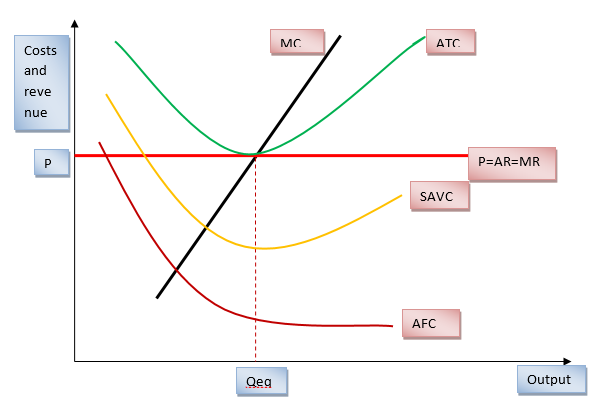
The figure shows short run Marginal cost curve (MC), Average total cost (ATC), short run average variable costs (SAVC), average variable cost (AFC) and revenue curves for a firm in a perfectly competitive market. The price is equal to the average cost and marginal revenue. This is due to perfect information about prices in the market. Equilibrium point is attained at the point where marginal revenue intersects the marginal costs curve. The equilibrium quantity is Qeq while the equilibrium price is P (Roger, 2008, p.78).
Imposition of taxes on perfectively competitive market
Assume that a lump sum tax is imposed on a firm selling alcoholic drinks. This will increase the fixed cost since lump sum tax is like a fixed cost to the firm. The increase causes an upward shift in the short run average total costs (SATC) and the average fixed cost (AFC). The average variable cost (SAVC) and the marginal cost (SMC) will not be affected given that the SMC curve is the supply curve of the firm.

From the graph, when taxes are imposed, the average fixed costs shifts outwards from AFC1 to AFC2. Similarly the average total costs also shifts from ATC1 to ATC2. The marginal cost, marginal revenue cost and short run average variable cost curves do not change. Equilibrium is the point of intersection of marginal cost and marginal revenue curve. From the graph, there is no change in the equilibrium position of the firm in the short run (Prusty, 2010, p.170).
Assume that the firm was operating in the long run before imposition of taxes and it was in equilibrium just earning normal profits. It will not be able to cover its higher (shifted) average total costs (SATC1) may be forced to go out of business in the long run. Consequently, in the long run, market supply curve will shift outwards (Dwived, 2006, p.247). The movement in the long run curve is shown in the graph below.

In the long run both the supply and demand curves are straight lines. They are obtained by summation of all short run curves. The initial supply curve is S while the demand curve is D. The equilibrium point is at point E with output at Q1 and price at P1. Imposition of taxes increases the cost of production of the alcoholic drinks, this causes the supply curve to shift outwards say from S to S1. The shift leads to a new equilibrium point E1 with increased prices to P2 and reduction in quantity produced to Q2. We can deduce that,
“In the short run, the lump sum tax will not affect the SMC curve and the firm will continue to produce the same output as before the imposition of tax. However in the long run, the industry will produce less output if there is imposition of lump sum tax. This is because of higher average total costs and some firms will go out of business if they cannot recover the increased average costs by selling the product at a higher price” (Prusty, 2010, p.172).
In the long run, the firm may be forced to shut down.
Taxes on a monopoly firm
Monopoly is a firm that is a sole seller of a product without close substitutes (Mankiw, 2009, p. 300). A monopoly remains the only seller in its market because other firms cannot enter the market and compete with it. Barriers to entry are from three main sources, first, “if a key resource required for production is owned by a single firm, also government can give a single firm exclusive rights to produce some goods or services and if a single firm can produce output at a lower costs than can a larger number of producers” (Mankiw, 2009, p.301). Monopoly firms always make supernormal profits.
This can be attributed to the fact that they have a declining average costs. Also, monopoly has the ability to influence price of its output. The demand curve of a monopoly is downward sloping. This indicates that if a monopolist raises the price of its good, consumers buy less of it. This provides a constraint on a monopoly’s ability to profit from its market power.
Government can also impose taxes on a monopoly as a way of regulating such firms (Dwived, 2006, p.246). Assuming that the alcoholic drinks were being sold in a monopolist market, the graphs will be as shown below.

Unregulated monopoly would produce Q1 units and charge a price of P3. This price is more than the equilibrium price enabling it to make excess profits. The excess profit is represented by the area MT per unit. “If the government intends to regulate monopoly price allowing some super normal profit, then one reasonable price is P2 where LMC=AR. If the price is fixed at P1, the monopolist would be left with normal profits only while output is maximum at Q3 under the given costs and revenue conditions. If price is fixed at P2, the monopolist gets some excess profit but the output is less than that at P1 by Q3-Q2” (Dwived, 2006, p.247). In both cases, if tax is imposed on the alcoholic drink, the monopolist would produce more output.
Reference List
Bernanke, B. and Frank, H. (2003) Principles of Microeconomics, 2nd ed., New York: McGraw Hill.
Boyes, W. and Michael, M. (2008) Microeconomics, 8th ed., New York: Joe Sabatino.
Dwived, D. N. (2006) Microeconomics: Theory and Applications, 1st ed., New Delhi: Dorling Kindersley (India) Pvt. Ltd.
Gordon, J. (2010) Tax Shake-up to Hit Beer, Wine Prices. Web.
Mankiw, G. N. (2009) Principles of Microeconomics, 6th ed., New York: Joe Sabatino.
Prusty, S. (2010) Managerial Economics. New Delhi: Asoke K. Ghosh, PHI Learning Private Limited.
Rittenberg, L. and Tregarthen, T. (2009) Principles of Microeconomics. 2nd ed., USA: Flat World Knowledge, Inc.
Roger, A. A. (2008) Economics. New York: Joe Sabatino.
Tewar, D. (1996) Principles of Microeconomics, New Delhi: New age international (P) Limited, publishers.
World Medical Association (2011) “WMA Statement on Reducing the Global Impact of Alcohol on Health and Society”. Web.